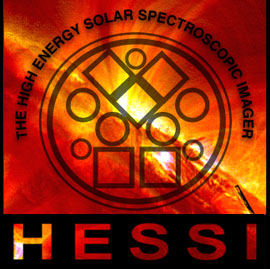|
Sun & Space Weather News 2004
[Current News] [2009 Archive] [2008 Archive] [2007 Archive]
[2006 Archive] [2005 Archive] [2004 Archive] [2003 Archive]
| |
|
|
| 12/08/04 |
|
SOLAR STORMS AFFECT COMETS TOO- There appears to be evidence that solar storms can destroy the ion tails of icy comets. Read the article here.
|
| |
|
|
| 11/17/04 |
|
PROTECTING ASTRONAUTS IN SPACE USING MAGNETIC FIELDS- Find out how magnetic fields could protect astronauts on their way to Mars and beyond. Read the article here.
|
| |
|
|
| 10/30/04 |
|
AN ACTIVE SUN - Solar activity increased sharply on Oct. 30th and several strong flares, including a brief X-flare, erupted from sunspot 691. Some of these explosions may be associated with coronal mass ejections (CMEs) headed toward Earth. If you are a sky watchers at high latitudes look for
spooky auroras in the night sky.
Visit http://spaceweather.com archives for more information and images
by selecting this date on the right side of the page. |
| |
|
|
| 10/25/04 |
|
LARGE SUNSPOT - During the weekend, a large spot on the surface of the Sun (a sunspot) grew to almost 10 times wider than Earth. This sunspot is surrounded by a number of other growing sunspots. The sunspot number has been low for weeks and with it the appearance of active aurora borealis (Northern Lights) further south has also been low. With this sunspot growing, we could see an increase in the Northern Lights at lower latitudes could
increase in the days ahead.
Visit http://spaceweather.com for more information. The archives will
tell more about this particular event for this date. |
| |
|
|
| 06/07/04 |
|
SOURCES OF SOLAR HAZARDS IN INTERPLANETARY SPACE
-
Life on Earth is nurtured by heat and light from the Sun. Yet
life on Earth also is inconvenienced, sometimes potentially threatened,
when the Sun sends out huge blasts of energy and high-speed particles.
On Earth, our atmosphere and magnetic field help protect us.
But in deep outer space, and on the surface of the Moon and Mars,
astronauts are vulnerable to solar eruptions.
Read the full story at http://spaceflightnow.com/news/n0406/05solarhazards/ |
| |
|
|
| 05/11/04 |
|
XMM-NEWTON DETECTS X-RAY 'SOLAR CYCLE' IN DISTANT
STAR: For years, astronomers have wondered whether stars similar
to the Sun go through periodic cycles of enhanced X-ray activity,
like those often causing troubles to telephone and power lines
here on Earth. Europe's X-ray observatory XMM-Newton has now revealed
for the first time a cyclic behaviour in the X-ray radiation emitted
by a star similar to the Sun. Read the full ESA News Release.
|
| |
|
|
| 04/26/04 |
|
HOT FLASHES: The light from the Sun seems regular
and steady, but research from the University of Southern California
paints a different portrait of a dynamic and chaotic star that experiences
a range of events. Small forces acting deep inside the Sun can lead
to significant changes on its surface, causing the flares and coronal
mass ejections that can strike the Earth. Scientists are still trying to understand
if there's a connection to the Sun's 11-year cycle of sunspots and temperature
changes on the Earth. (Full Story) |
| |
|
|
| 04/07/04 |
|
AURORA WATCH: A coronal mass ejection (CME) hurled
into space by a solar explosion on April 6th is heading in the general
direction of Earth. Sky watchers should be alert for auroras when
it arrives, probably during the early hours of April 8th UT (for
North Americans, that means during the night of April 7th).
Earth is already skirting through a solar wind stream flowing
from a coronal hole on the sun. Because of this, geomagnetic storms
and auroras are likely, off and on, for the next few days. The
best displays will be at high latitudes--e.g., Canada and Alaska.
When the incoming CME arrives, auroras could descend to lower latitudes,
too.
Visit http://spaceweather.com archives for more information and images by selecting this
date on the left of the page. |
| |
|
|
| 02/25/04 |
|
BIG SUNSPOT: There's a big spot on the sun
today, sunspot 564. It first appeared only a few days ago, tiny
and unremarkable. Since then it has grown wider than eight planet
Earths. The active region can be seen without a telescope--but
never look directly at the sun. Unfiltered sunlight can damage
your eyes.
Visit http://spaceweather.com archives for more information and images by selecting this
date on the left of the page. |
|
|

RHESSI
How energy is released in flares on
the Sun

STEREO/IMPACT
How Coronal Mass Ejections
from the Sun erupt and propagate through the solar wind

THEMIS
What makes the aurora erupt
globally? The substorm onset problem

WIND
The solar wind is a dynamic and complex electrified and magnetic gas.
|